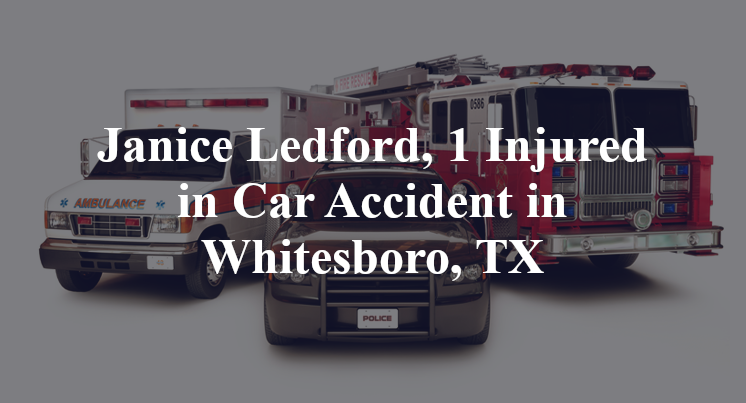Janice Ledford, 1 Injured in Car Accident in Whitesboro, TX
Grayson County, TX — July 30, 2024, Janice Ledford and one other person were injured in a car accident at about 8:00 a.m. along U.S. Highway 377.
According to authorities, 71-year-old Janice Ledford was traveling in a southbound Ford F-150 pickup truck on U.S. 377 at the Union Street intersection when the accident took place.

Officials indicate that, for as yet unknown reasons, an eastbound Buick occupied by a 26-year-old woman entered the intersection at an apparently unsafe time, failing to yield the right-of-way at a stop sign. A collision consequently occurred between the front-end of the pickup truck and the left side of the Buick.
Both Ledford and the woman from the Buick reportedly sustained serious injuries over the course of the accident. They were each transported to local medical facilities by EMS in order to receive necessary treatment. Additional details pertaining to this incident are not available at this point in time.
Commentary
Collisions at intersections often come down to a matter of timing, but understanding how that timing broke down requires more than just a glance at the wreckage. When multiple people are seriously hurt, it’s fair to ask whether enough was done to uncover what really happened.
1. Did the authorities thoroughly investigate the crash?
A crash where a vehicle reportedly fails to yield at a stop sign and is struck by cross-traffic should prompt a detailed reconstruction of the moments before impact. Did investigators measure distances, check for line-of-sight limitations, or determine the speed of both vehicles as they approached the intersection? Was there any attempt to digitally map the scene or re-create how long each vehicle had to react? Without that kind of groundwork, key questions about timing and driver behavior may go unanswered—especially when both drivers were injured and unable to offer immediate accounts.
2. Has anyone looked into the possibility that a vehicle defect caused the crash?
It’s easy to chalk up a failure to yield as a mistake, but it's also possible that one of the vehicles didn’t perform as expected. Was the Buick’s braking system working properly? Could there have been an issue with throttle control or steering? On the pickup’s side, was the collision avoidable, or did a mechanical issue affect maneuverability or stopping distance? These kinds of possibilities are only addressed if someone conducts a proper post-crash inspection—and in many cases, that step never happens.
3. Has all the electronic data relating to the crash been collected?
Both the Buick and the F-150 likely had electronic systems that recorded critical data: speed, brake usage, throttle response, and steering inputs in the seconds leading up to impact. That kind of evidence can either support or challenge what witnesses or drivers recall. There may also be nearby cameras—at businesses, intersections, or even dashcams—that captured footage. Whether anyone moved quickly to collect and preserve that material remains an open question.
When serious injuries are involved, assumptions aren’t enough. Getting to the bottom of a crash means taking the time to look at what can’t be seen with the naked eye—and asking the questions others might overlook.
Takeaways:
- Intersection crashes need precise reconstruction to reveal what each driver saw and did.
- Brake or steering failures can mimic driver error and must be ruled out.
- Electronic vehicle data and nearby video footage often hold key answers.

*We appreciate your feedback and welcome anyone to comment on our blog entries, however all visitor blog comments must be approved by the site moderator prior to showing live on the site. By submitting a blog comment you acknowledge that your post may appear live on the site for any visitors to see, pending moderator approval. The operators of this site are not responsible for the accuracy or content of the comments made by site visitors. By submitting a comment, blog post, or email to this site you acknowledge that you may receive a response with regard to your questions or concerns. If you contact Grossman Law Offices using this online form, your message will not create an attorney-client relationship and will not necessarily be treated as privileged or confidential! You should not send sensitive or confidential information via the Internet. Since the Internet is not necessarily a secure environment, it is not possible to ensure that your message sent via the Internet might be kept secure and confidential. When you fill out a contact or comment form, send us an email directly, initiate a chat session or call us, you acknowledge we may use your contact information to communicate with you in the future for marketing purposes, but such marketing will always be done in an ethical way.